Papers by Juan Antonio Araiza Aguilar

Recycling, 2024
Over the last two decades, the use of bioreactors filled with aged refuse extracted from closed a... more Over the last two decades, the use of bioreactors filled with aged refuse extracted from closed areas of landfills has proven to be a viable alternative for the treatment of different types of wastewater. This study presents the results obtained during the evaluation of aged refuse used as filling material for a downflow bioreactor during the removal of the organic load present in wastewater generated in the wet processing of coffee. The tests were carried out over a period of 120 days, with 15 days to start up and stabilize the bioreactor and 105 days to perform treatability tests. The aged refuse, once extracted, was dried and sifted to a particle size of less than 50 mm. The bioreactor used had a cylindrical geometry (Ø = 0.20 m, and h = 3.40 m), and it was fed with hydraulic loads of 50, 100, and 150 L m−3 d−1. The analysis of the data obtained shows that the system studied achieves the removal of 98.3% of the initial organic load when fed with 150 L m−3 d−1. This showcases recycling aged refuse as a technically viable alternative to treat the wastewater generated during coffee processing. Also, the evaluated system has the advantage of needing a short period of time to achieve its stabilization, which turns out to be of great value, especially in its possible use in the treatment of residual water generated in the harvest of agricultural products where the period of harvest is very short.

Urban Science, 2024
In this paper, a proposal was presented to improve the MSW collection service in the municipality... more In this paper, a proposal was presented to improve the MSW collection service in the municipality of Reforma, in Chiapas, Mexico. Specific field work was developed and various spatial analysis techniques were applied in the GIS environment. The application of a multivariate analysis technique (Grouping Analysis) allowed the study area to be clustered into three waste collection sectors with common characteristics, which were the basis for generating three collection route scenarios. Scenario 1 corresponds to the current situation, where 478 waste collection points are served, with an average travel distance of 60.30 km and a collection time of 8.00 h. Scenario 2 was generated through the “maximize coverage” algorithm and vehicle route modeling in ArcGis 10.8. In this scenario, 1220 waste collection points are served, with an average travel distance of 143.21 km and an average collection time of 12.38 h. Scenario 3 was created using the “minimize facilities” algorithm, as well as collection modeling in ArcGis 10.8. Using this algorithm, impedances (distances) were automatically minimized so that 697 waste collection points could be served, with an average travel distance of 100.00 km and an average collection time of 9.66 h. In terms of improvement, scenario 3 gives the best results, because it minimizes distances and average travel times.
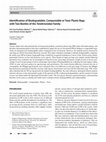
Journal of Polymers and the Environment, 2023
Various studies have demonstrated the environmental problems caused by plastic bags (PB) made wit... more Various studies have demonstrated the environmental problems caused by plastic bags (PB) made with hydrocarbons, and therefore international policies have been established to replace the use of conventional PB by biobags or compostable bags, which are designed to be biodegradable and/or composted in the environment. However, the methods used to characterize such bags are still far from being effectively assessed. This study evaluated a technique to identify biodegradable, compostable and/or toxic PB by feeding compostable bags certified by recognized institutions to larvae of the Tenebrionidae family, particularly Tenebrio molitor and Zophobas morio species. Three brands of single-use bags were studied, and the following parameters were evaluated: rate of consumption (of bags by larvae), percentage of biomass (weight increase in larvae), percentage of survival (percentage of larvae eating bags), percentage of biodegradability by evaluating the total organic carbon (TOC) in stool, and stool analysis by spectroscopy and spectrometry. The results showed differences between the rate of consumption, the EHappy bag being the most consumed; there were differences in the percentage of biomass, the EHappy bag showing less potential for biomass increase; both species showed lower survival with the Ealternative bag. TOC evaluation indicated that the WCare bag presents the highest biodegradability; the total reflectance attenuated infrared analysis showed a decrease in the representative peaks of the spectrum of PB, evidencing biodegradation; and the amount of metals in feces was found within the Maximum Permissible Limits. The two species showed a good performance, demonstrating that they can be used as a suitable and viable tool to evaluate toxicity, biodegradability and compostability.

Processes
Sugar is the most important food supplement of our daily diet. During the production, sugar mills... more Sugar is the most important food supplement of our daily diet. During the production, sugar mills use a large volume of water and produce a significant amount of wastewater polluted with high organic compounds. Therefore, it is necessary to treat the wastewater before their disposal. For this reason, this article presents the results obtained from the monitoring of a coupled system of aged refuse filled bioreactors (ARFB) in full scale to treat wastewater from a sugar mill. The coupled system consists of two bioreactors (a primary one -ARFB1- and a rectification one -ARFB2-) arranged in a series with identical geometries. The ARFB1-ARFB2 system was evaluated in two stages. The first stage (maintenance period) for 28 weeks, and second stage (Zafra season) for 29 weeks. The system was fed with sugar mill wastewater (SMW) with a chemical oxygen demand (COD) of 2787 ± 1552 mg/L and 2601 ± 722 mg/L, respectively. As results, we observed a rapid stabilization of the system over 2 months. ...

Environmental Engineering and Management Journal, 2021
This paper evaluates the products generated by Unmanned Aerial Vehicles used as tools to survey o... more This paper evaluates the products generated by Unmanned Aerial Vehicles used as tools to survey objects on surfaces. A Digital Elevation Model obtained from a photogrammetric process is then compared with another model obtained from a traditional Total Station survey. Different precision metrics are used, both for the Digital Elevation Models generated and for the points collected. The results of both forms of surveying objects on surfaces show that the products obtained with the photogrammetric method deviate importantly from those obtained with the Total Station survey (overestimations in some points of up to 50 cm). However, because it results in significant time savings in data collection, the photogrammetric method is generally more useful. The precision values of the Digital Elevation Model produced by the photogrammetric method give a ground resolution of 4.79 cm/pix, a mean error of ground control points of 1.31 cm and a point density of 436 points/m 2. On the other hand, the comparative precision values between the products of both survey methods are 0.23 m in the Absolute Mean Deviation and 0.58 m in the Root of the Mean Square Deviation. Additionally, more precise metrics were also obtained by analyzing zones with different densities of collected points. It should be noted that the main differences between the products of both survey methods were due to the low density of sampling points within the study area, particularly in the case of Total Station survey.

Environmental Monitoring and Assessment, 2021
The objective of this paper is to offer an approach to assess the risk associated with Municipal ... more The objective of this paper is to offer an approach to assess the risk associated with Municipal Solid Wastes, in a geospatial context. Initially, a risk index including hazard, vulnerability and other important variables was built. The built model is based on multi-criteria evaluation techniques and geographic information systems. Subsequently, the constructed index was used to model possible damage in various municipalities of the state of Chiapas, Mexico. The results indicate that the highest levels of risk are found in places with unfavorable conditions, such as high rates of waste generation, low waste collection coverage, steep slopes, etc. that cover 6.22% of the study area. The areas with high risk level are mainly found in the southeast of the municipalities of Villa Corzo and Villaflores, and cover 27.06% of the study area. The places of low and very low risk levels are concentrated in the center and northeast of the study area, in the municipalities of Suchiapa, Chiapa de Corzo and Acala, and cover 38.6% of the area. At the municipal level, Berriozábal, Villaflores and Villa Corzo have the highest levels of risk in most of their territory; the high levels of risk presented in Berriozábal are due to the limited territorial area that it occupies in the study area. In Villaflores and Villa Corzo, the high levels of risk are due to the high population dispersion. A large part of Tuxtla Gutiérrez territory presents low and medium risk levels, especially within the population settlement. The peripheral areas show the highest levels of risk, because the waste collection service is not provided very often. Finally, the Cohen’s kappa statistic used to validate the precision of the model gave a value of 0.34, which means that the spatial model can be considered acceptable despite its low value. Although this work is only a general approach to spatial risk modeling at a regional scale, it provides interesting information. Moreover, it adds to the few efforts that exist in the literature to model the risk associated with wastes.
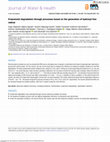
Journal of Water and Health, 2021
Pharmaceutical substances such as propranolol (PRO) are an emerging class of aquatic contaminants... more Pharmaceutical substances such as propranolol (PRO) are an emerging class of aquatic contaminants that have increasingly been detected in ground and surface water. For this reason, the aim of this study was to evaluate the efficiency of advanced oxidation systems for the PRO degradation. The tests started with anodic oxidation (AO), using 0.01, 0.05, and 0.1 M Na2SO4 as the supporting electrolyte and 16, 32, 48, and 64 mA cm−2 as current density. Under the best conditions obtained in AO, the electro-Fenton (EF) process was reviewed, where the effect of Fe2+ was analyzed with 5, 10, 15, and 20 mg Fe2+ L−1. The Fenton reaction (FR) was studied using the Fe2+ concentration that promoted the highest percentage of PRO removal and initial concentration of 16 mg L−1 of H2O2, in addition to these conditions, in the photo-Fenton (PF) system, the effect of UV light with wavelengths 254 and 365 nm were evaluated. The results obtained showed that the degradation efficiency of the EF > AO >...

Revista Mexicana De Ingenieria Quimica, 2018
El amplio espectro de moleculas contaminantes biorrecalcitrantes presentes en lixiviados, hacen d... more El amplio espectro de moleculas contaminantes biorrecalcitrantes presentes en lixiviados, hacen de estos liquidos un problema de contaminacion dificil de atender. Una tecnologia recientemente probada para su tratamiento se fundamenta en el uso de materiales estabilizados. En el presente trabajo se evaluo el potencial biologico de estos materiales empleandolos en el tratamiento de lixiviados mediante el uso de biorreactores empacados. Los materiales estabilizados, extraidos del relleno sanitario de la ciudad de Tuxtla Gutierrez, Chiapas, Mexico, se caracterizaron con parametros granulometricos, humedad, solidos volatiles, cenizas y peso volumetrico. Asi tambien se realizo una caracterizacion microbiologica que permitio identificar la presencia de ocho especies relacionados con la degradacion y mineralizacion de compuestos organicos. La operacion del biorreactor fue monitoreada durante un ano bajo cuatro cargas hidraulicas de lixiviados (10.5, 18, 26 y 41 L/m 3 -d). La maxima eficienc...

Resources Environment and Information Engineering, 2021
In the field of solid waste management, key concepts such as risk, impact and hazards have been u... more In the field of solid waste management, key concepts such as risk, impact and hazards have been used interchangeably and have had imprecise meanings and scopes; this can lead to a partial or biased vision, for example in relation to municipal solid waste management policies. This paper presents a review of the literature on the theme of municipal solid waste and risk. Analysis of scientific publications from the years 1970 to 2020 shows that the concept of risk in the field of solid waste has been approached from various perspectives and different interpretations. Of all risk components, vulnerability has been the least addressed in the literature, because technical aspects such as hazard modeling predominate in this field. Most of the publications have studied the final disposal stage, since open dumpsites and landfills are still the most common methods for disposing of solid waste. Finally, a reference framework is proposed.
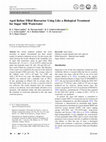
Sugar Tech, 2020
The serious pollution problem that exists nowadays in aquatic environments has been caused, mainl... more The serious pollution problem that exists nowadays in aquatic environments has been caused, mainly, by intensive industrial activity. For this reason, this article presents the results obtained in the treatability tests of sugar mill wastewater, using an aged refuse filled bioreactor, (Ø = 0.2 m, h = 3.0 m, of PVC), which was fed under four hydraulic loads (50, 100, 150 and 200 L/m 3day), each of them for a period of 8 weeks. The efficiency of the system was evaluated by the removal of the chemical oxygen demand (COD) and color. The average values in the influent were 2473 ± 437 mg/L for COD and 1048 ± 287 Pt-Co for color. The highest COD removal (98.8%) was achieved with a hydraulic load of 100 L/ m 3 day, generating an effluent with an average value of 26.8 mg COD/L. In the case of color, a removal of 84.2% was achieved. The results obtained show the evaluated system as an efficient, novel and friendly alternative in its operation, with minimum sludge and odors generation in the treatment of wastewater generated in the cane sugar extraction process.
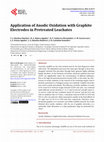
Open Journal of Applied Sciences, 2020
Currently, landfills are the main method used for the final disposal of urban solid waste. The de... more Currently, landfills are the main method used for the final disposal of urban solid waste. The degradation processes that waste goes through in these sites, alongside rainwater that percolates through them, generate highly polluting liquids (leachate). In the treatment of leachate, advanced oxidation processes (AOP) can significantly reduce the concentrations of different pollutants. Due to the high documented potential around AOPs, in this study, the effectiveness of anodic oxidation in the removal of the remaining organic load in leachates pretreated in a biological system was evaluated. Graphite electrodes were used as anode and cathode. The efficiency of anodic oxidation, in terms of the removal of chemical oxygen demand (COD) and color, was evaluated under different current densities (7, 12, 17 and 22 mA/cm 2) and pH values (3, 4.5 and 6). Under the best conditions found (22 mA/cm 2 and pH of 6) and with an oxidation time of 5 hours, a maximum removal of 68% in COD and 91% in color was achieved, which represented a quality in the final effluent of 271 mg/L and 151 Pt-Co in COD and color, respectively. Therefore, considering that graphite is an economic and widely available material, the results obtained show anodic oxidation, with the use of graphite electrodes, as a technically viable alternative as a final purification stage for pretreated leachates.

Sustainability, 2019
This paper proposes a solution to the current problems of Mexico City (Ciudad de México) with res... more This paper proposes a solution to the current problems of Mexico City (Ciudad de México) with respect to construction and demolition waste, through a spatial analysis to locate a waste treatment and disposal infrastructure. Two analysis methodologies, specifically the multi-criteria evaluation technique and network analysis, are used with the support of geographic information systems. The results of the multi-criteria evaluation technique indicate that the most suitable places for this infrastructure location are in the south and southeast of the study area, in the Tlalpan, Milpa Alta, Xochimilco and Cuajimalpa boroughs. The results of the network analysis technique indicate that four facilities strategically located in Miguel Hidalgo, Gustavo A. Madero, Tlahuac and Tlalpan boroughs would permit the provision of service to almost all waste generation points in the study area. Decision makers in Mexico City can use either of the two approaches. If the objective is to find the best lo...

ISPRS International Journal of Geo-Information
In this study, the operation of a final disposal site for municipal solid waste in the state of C... more In this study, the operation of a final disposal site for municipal solid waste in the state of Chiapas, in Mexico, was evaluated. Several spatial analyses and Geographic Information Technology (GIT) tools were used. It was found that the site’s current operation and location are deficient, partially complying with regulations. The gaseous dispersion is not far-reaching (from 100 to 8725 µg/m3 for landfill gas, and from 0.01 to 0.35 µg/m3 for H2S) but requires attention to avoid olfactory unpleasantness. Liquid emissions (conservative pollutants) move in the east direction of the final disposal site, which can damage the environmental infrastructure (water supply wells) in the long term. The highest and lowest concentrations were found in years 1 (12,270 mg/m3) and 20 (1080 mg/m3), respectively. Thermal emissions around the dumping site are important due to the formation of microclimatic zones. Temperature differences were found during the analysis period, ranging from 8.37 °C in su...

Revista Internacional de Contaminación Ambiental
Palabras clave: caracterización, generación, muestreo, subproductos RESUMEN Los estudios de gener... more Palabras clave: caracterización, generación, muestreo, subproductos RESUMEN Los estudios de generación y cuantificación de subproductos de los residuos sólidos urbanos, proporcionan herramientas base para la toma de decisiones en los municipios y en las localidades de México. Este trabajo fue realizado en la cabecera municipal de Berriozábal, Chiapas. Como resultados se determinó que la generación per cápita de residuos sólidos urbanos es de 0.619 kg/hab/d, la fracción doméstica equivale a 0.456 kg/hab/d y la no doméstica a 0.160 kg/hab/d. Respecto a la composición, se encontró que la fracción orgánica sigue manteniendo porcentajes altos (54.88 %), seguido de otros subproductos como plásticos (11.70 %), además de papel y cartón (6.87 %). Poco más de 78 % podría ser considerado como susceptible de recuperación, por lo que podrían ser aprovechados de alguna manera para no enviarlos directamente a disposición final y con ello alargar la vida útil de los sitios de depósito de residuos.
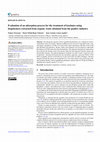
Chemical Reports
The adsorption capacity of three eggshell bioadsorbents was evaluated to remove contaminants from... more The adsorption capacity of three eggshell bioadsorbents was evaluated to remove contaminants from raw leachate. Optimal conditions for the removal of suspended solids, color, and organic compounds, as COD, were achieved by batch experiments with three levels of pH and absorbent concentrations. Kinetic studies and isotherms were developed to understand the behavior of COD removal by the bioadsorbents. The chemical and physical characterizations indicate the leachate used in the present study had characteristics between mature and intermediate leachates. The optimal adsorption conditions were pH 2.0 and 1.0 gram (0.5 g/L) of adsorbent. Adsorbent M showed the best adsorption capacities, removing 99.06% (1446 NTU) of turbidity, 86.25% (4140 UPt-Co) of color and 54.56% of COD (1530mg/L). The data obtained through the kinetic and isothermal tests were better fitted to the pseudo first order and Langmuir models, with an equilibrium adsorption capacity (Qe) of 139 mg of COD/g of adsorbent a...

Transylvanian Review, 2018
Public markets and supermarkets are one of the largest solid waste generators in Mexico City. Bas... more Public markets and supermarkets are one of the largest solid waste generators in Mexico City. Based on Mexican regulations, markets and supermarkets should have an efficient solid waste management system. However, currently there are not waste management plans; wastes are routinely mixed and separation is scarce. For that reason, the goal of this research was to propose a Solar Drying Systems for treatment fruits and vegetables before they are a waste or arrive at the trash can due to its decomposition, to prolong their availability on the markets and supermarkets. Likewise, an unconventional technology was proposed for treating organic wastes. There are 329 public markets and 332 supermarkets in Mexico City with no waste management strategies, the biggest problem being the temporary storage of the wastes. The most common solid wastes were: food residues, cardboard, paper and plastics, while metals, Styrofoam and rubber represented the smallest part of solid wastes. Citrus wastes we...
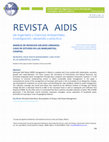
El manejo de los Residuos Solidos Urbanos (RSU) en Mexico es complejo y ha evolucionado a la par ... more El manejo de los Residuos Solidos Urbanos (RSU) en Mexico es complejo y ha evolucionado a la par de la urbanizacion, del crecimiento economico y la industrializacion. Por estas razones la Secretaria del Medio Ambiente y Recursos Naturales ha promovido la gestion integral de residuos a traves de planes, programas y de un marco regulatorio; sin embargo, aun es necesario continuar instrumentando acciones para alcanzar un manejo sustentable de los residuos. En el presente documento se elaboro una revision exhaustiva de la gestion y manejo de los RSU en el municipio de Las Margaritas, Chiapas, especificamente su Cabecera Municipal, evaluando su estado actual e identificando los principales problemas relacionados al manejo de los residuos; encontrandose coberturas de recoleccion muy por debajo de lo reportado por el Instituto Nacional de Ecologia y Cambio Climatico (81.61% a nivel cabecera y 21.48% a nivel municipal), asi como una mala disposicion final. Por otro lado, se estima que pudie...

Ingeniería, 2017
Los residuos electronicos han aumentado de manera importante en todas las regiones del mundo, deb... more Los residuos electronicos han aumentado de manera importante en todas las regiones del mundo, debido a que la utilizacion de aparatos y equipos electronicos se presentan de manera masiva en los distintos sectores de la vida del ser humano (industrial, servicios, economicos. etc.), incidiendo esta situacion en una nueva problematica de tipo socio-ambiental, de salud, y donde las instituciones educativas no son ajenas a esta problematica. En este trabajo se realizo un diagnostico de la situacion actual respecto al manejo de los residuos electronicos generados en la Universidad de Ciencias y Artes de Chiapas, cuantificando los tipos de residuos electronicos y se plantearon propuestas de solucion para contrarrestar lo acontecido actualmente. Como resultados del diagnostico, se encontro que, del total de los articulos almacenados en las bodegas de la institucion, el 66% son residuos electronicos, en su mayoria equipos de computo y monitores tipo CRT. Con respecto a las etapas de manejo d...

Transylvanian Review, 2020
The objective of this work was to evaluate the feasibility of using cellulosic waste from the pap... more The objective of this work was to evaluate the feasibility of using cellulosic waste from the paper and construction industry for manufacturing materials, such as bricks, for sustainable buildings. In this project bricks were manufactured with sludge from the paper industry, and construction waste (6.3 mm to fines, all-in-one) and lime, cement from a material bank. Physicochemical and microbiological tests were conducted on paper industry sludges to document the harmlessness of their handling. Subsequently, brick-making mixtures were designed. The specimens were subjected to compressive strength and initial and maximum absorption, erodibility tests according to the specifications of Mexican Standard. These tests showed that the most appropriate brick-making mixture consisted of sludge (with high concentrations of cellulosic waste) from the paper industry (5.5%), lime (7%), cement (7%) and construction waste (80.5%). The results showed a compressive strength of 5.6 MPa (57 kg/cm 2 ),...
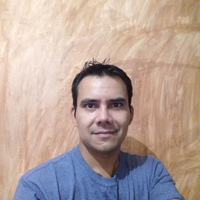
Uploads
Papers by Juan Antonio Araiza Aguilar
Cuando se manejan inadecuadamente estos residuos, suelen provocar serias afectaciones al ambiente, como la contaminación atmosférica, de aguas superficiales y subterráneas, de suelos, la muerte de especies de flora y fauna; además de diversos problemas dentro de los asentamientos urbanos, por ejemplo, inundaciones por la obstrucción de los sistemas de alcantarillado, malos olores y, daños a la salud humana. Esta serie de estragos en términos muy generales, pueden ser considerados como el riesgo ocasionado por un mal manejo de los residuos sólidos urbanos.
Esta tesis, constituye uno de los primeros acercamientos internacionales por abordar el tópico de riesgo asociado a residuos, particularmente desde un punto de vista espacial, ya que en la actualidad existen muchos vacíos en esos temas. El trabajo propone modelar espacialmente el riesgo a partir de la creación de un índice, el cual emplea a los componentes más importantes, como amenaza y vulnerabilidad. Con los resultados generados, se espera aportar nuevas ideas, conceptos y flujos de trabajo, que sirvan para mejorar las pocas metodologías existentes, donde el tópico de los residuos no juega un papel importante en los procesos de gestión territorial del riesgo.
El área de estudio abordada en esta investigación, fue la denominada Cuenca del Cañón del Sumidero, en el estado de Chiapas, específicamente se consideró a los municipios que la integran, los cuales en los últimos años han presentado un enorme deterioro, reflejo de una falta de planeación y ordenamiento de las actividades productivas dentro de esa cuenca.
La metodología de este trabajo consistió de tres etapas. Inicialmente se desarrolló un marco conceptual base para poder realizar evaluaciones de riesgo asociado a residuos. Se inició con una revisión profunda de la literatura nacional e internacional; generándose conceptos específicos de riesgo, amenaza y vulnerabilidad. También se efectuó un análisis de los variados enfoques del riesgo que existen en el tópico de residuos, describiéndose a cada uno de ellos. A la par de la búsqueda bibliográfica, se realizaron visitas a la zona de estudio, con la finalidad de realizar un diagnóstico regional.
En la segunda etapa se construyó el índice de riesgo, el cual se basó en una función lineal de tipo aditiva-ponderativa, en la que cada componente es adicionado de manera individual, para luego obtener el riesgo. El interior de cada componente está formado por diversas variables del medio físico, social, biológico y otras relacionadas con los residuos sólidos. Estas variables fueron ponderadas mediante técnicas de comparación pareada.
En adición a lo anterior, también se consideraron dos visiones o formas de analizar el riesgo; la primera de ellas está relacionada con las afectaciones del humano, ya sea por contacto directo o indirecto con los residuos (denominado sistema social); mientras que la segunda visión se relaciona con las afectaciones o daños en los ecosistemas, es decir, sobre el agua, aire, suelo, flora y fauna (denominado sistema ambiental).
En la última etapa de este trabajo, se utilizó una técnica de evaluación multi-criterio en el ambiente de los sistemas de información geográfica, con la finalidad de modelar espacialmente el riesgo; al concluir el análisis espacial, se procedió a validar la cartografía generada por medio de técnicas como la matriz de confusión.
Dentro de los resultados más importantes de la revisión bibliográfica, destacan la identificación de cinco enfoques del riesgo asociado a residuos, por ejemplo, i) riesgo ambiental y ecológico, ii) riesgo epidemiológico y sanitario, iii) riesgo ergonómico u ocupacional, iv) riesgo químico y tecnológico, e v) impacto o seguridad ambiental; lo que demuestra que no existe un lenguaje en común al abordar estos tópicos.
Respecto a la modelación espacial del riesgo en el área de estudio, los niveles más altos se concentraron de manera particular, en todos aquellos lugares que presentan condiciones muy desfavorables, por ejemplo, altas tasas de generación de residuos, una cobertura y frecuencia de recolección muy baja, pendientes muy pronunciadas, densidad de habitantes muy alta, etc. Adicionalmente, se identificaron dos tipos de superficies territoriales con los niveles más altos de riesgo: i) superficies que generan residuos por albergar zonas poblacionales y; ii) superficies territoriales a las que arriban los residuos de manera incidental.
Finalmente, se puede concluir que este trabajo proporciona algunas pautas para realizar un análisis espacial del riesgo asociado a residuos, de tal manera que pueda ser replicarlo en otros lugares. Adicionalmente, a través del marco conceptual desarrollado, se definió claramente cuáles son los componentes del riesgo, y cómo deben ser abordados cada uno de ellos.
clave para la toma de decisiones, en lo relacionado con la selección de
sitios para emplazar infraestructura de depósito de RC&D, para que su
operación sea económicamente factible y con mínima afectación ambiental.
Asimismo, se consideran los siguientes objetivos particulares:
✤ Presentar de forma clara la descripción de las acciones involucradas
en el proceso selección de áreas y sitios de emplazamiento
de infraestructura de depósito de RC&D.
✤ Describir las variables o criterios que participan en los procesos
de selección de áreas y sitios factibles para el emplazamiento de
infraestructura de depósito de RC&D.
✤ Explicar en qué consisten los estudios básicos o mínimos para la
selección de sitios factibles para emplazamiento de infraestructura
de depósito de RC&D.